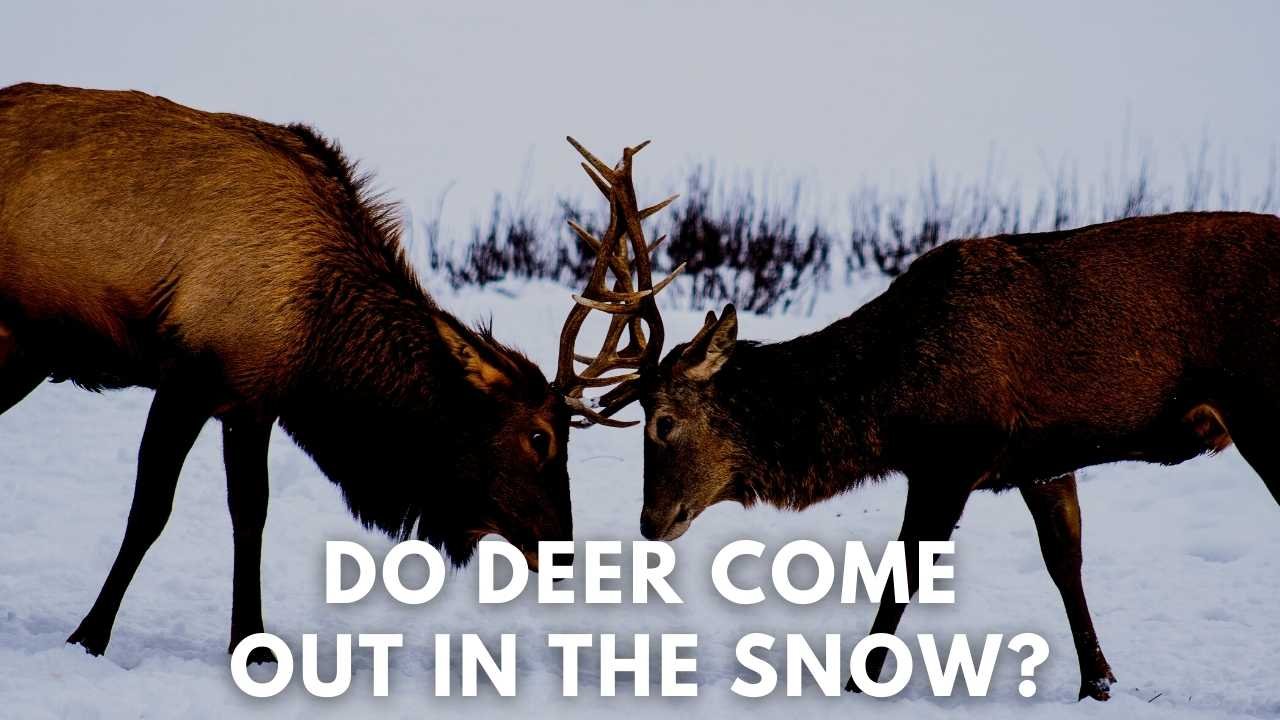An almost beautiful new beginning might be brought by fresh snow. You can suddenly move stealthily through the forest. Bucks are active and simple to identify. And if you succeed, a clear blood trail will take you right to your prize. However, not all snow is beneficial. For instance, a wind-driven blizzard can keep bucks in their beds for days, and crusted snow can send bucks running from your footfalls. The white stuff, as it happens, comes in a variety of forms that have an impact on deer behavior and hunter success in different ways.
So, do deer come out in the snow? Heavy snowfall and blizzard conditions have a tendency of causing some fantastic deer movement both before and after the front. Deer are compelled to hibernate for several days at a time during blizzards, which can be beneficial for wildlife.
Do deer come out in the snow?
Deer don’t have cellphones with weather apps, but they can feel the future, and their sensory organs appear to be much more acute than ours. All wildlife, not just deer, prioritizes grazing during the calm before the storm when a low-pressure system is rapidly approaching.
Sportsmen with experience know that hunting before a significant snowstorm may be fantastic. Deer will be up and going when they detect it coming.
But, what if you had one last day of hunting while snow is literally falling across the landscape like a blanket?
Actually, even in the midst of a snowfall, you may still harvest a good buck. It’s also simpler in certain respects than when it’s not snowing. This is due to the deer being concentrated around you rather than dispersed in various feed locations or looking for late estrous does.
Deer activity and behavior vary most noticeably during and after a significant snowfall. Deer can usually predict when there will be a significant downpour by the chill, moist feeling in the air and the imposing wall of dark clouds engulfing the sky.
Whitetails often remain in their safe bedding location for a day or more after receiving more than six inches of snow.
Even after the storm has passed, deer choose to cluster together under the cover of the tall pines and remain there.
Do deer come out when snowing?
Deer move easily in the light snow that a weak winter front brings. Deer will generally move well in a misting rain linked with a dropping barometer at any time of the season. Deer, however, hide out when the showers turn into a continuous storm. You probably should too.
Where do the deer go when it snows?
Deer often seek out more protected spots to rest and feed, such as clusters of coniferous trees that keep their needles throughout the winter and allow snow to accumulate, both of which contribute to some wind resistance and potential cover.
Do deer like to move when it’s snowing?
Deer adore moving through dry, light, fine snow. Take a position overlooking a path and let them come to you. Avoid bedding regions at all costs because late-season bucks are very cautious.
Is deer hunting better in snow?
Winter weather makes late-season deer hunting challenging, but terrible weather days like rain and snow give the best deer-hunting opportunities. The bad weather works in your favor. You can stay hidden in the wind, which makes it harder for deer to scent you and masks your movements in the woods.
What do deer do in the snow?
Deer like to take refuge in places that offer more protection from the elements yet are close to a reliable source of food. Deer behave similarly to humans during very bad weather: they bunker down and can remain there for days.
How do you follow deer tracks in the snow?
Discover what appear to be recent deer trails. Make a palm print in the snow next to them, then push the edges. Press the hoof print’s midline and outer edges now. The snow will give way just as easily on a hot track.
How do bucks track in snow?
To make up for lost time, you must proceed quickly. It’s time to utilize your eyes more than your feet if and when you feel like you’re closing in. Move quietly and gently, pausing frequently to look in both directions as you go. The deer must be located before it finds or scents you.
How cold is too cold for deer?
They develop an undercoat that is incredibly dense and has hollow “guard hairs” that are excellent insulters. These adaptations allow deer to endure temperatures as low as 30 below zero.
Do whitetail deer move during snow storms?
Yes, despite the fact that it may seem odd, the worse the weather, the more likely you are to see that large buck who survived the rut. Whitetail do not need to expose themselves at this time in the season unless they are compelled to do so when blizzards, temperatures below zero, and windy weather sweep through a region.
Why do deer dig in the snow?
Deer spend a significant portion of the fall season accumulating fat reserves that will give them energy and warmth throughout the winter. Deer grow a thick winter coat of fur on the outside that increases their ability to absorb sunlight and retain body heat.
Conclusion
Even though it doesn’t happen very often, deer occasionally come out in the snow. That is the perfect time for you to hunt because deer are easily spotted in the snow.

